Superconductors: The latest in offshore wind power generation
The nascent offshore wind industry in the U.S. has yielded technological breakthroughs and is continuously developing the infrastructure that will make offshore wind a viable and sustainable source of renewable energy in the country. One of such efforts focuses on finding a way to “increase the power of offshore turbines without making them too massive to build,” as Denmark has done in the past year with the hoisting of the first superconducting wind turbine generator.
Earlier this year, the U.S. Department of Energy (DOE) selected projects totaling up to $8 million to develop next-generation wind turbine drivetrain technologies that will “facilitate the continued growth of wind turbines for both land-based tall wind and offshore applications.” According to the DOE, these projects will “develop more efficient, smaller, and lighter-weight generators that will lower costs and make wind power more affordable.” Each project is expected to be scaled up to at least 10 megawatts and, if successful, can result in 50% smaller and lighter designs and cost reduction of wind generation by 10 to 25%.
The University of Alaska Fairbanks defines superconductors as a “material that can conduct electricity or transport electrons from one atom to another with no resistance.” Essentially, no heat, sound or any other form of energy would be released from the material when it has reached “critical temperature,” which is the temperature at which the material becomes superconductive. Superconductors are currently used in several devices such as Magnetic Resonance Imaging (MRI) and is being explored on projects that will create “high speed trains that hover above the track,” which would nearly eliminate all of the power lost in transit.
At present, two projects in the U.S. are in development stages:
- American Superconductor Corporation of Ayer, Massachusetts will develop a high-efficiency lightweight wind turbine generator that incorporates high-temperature superconductor (HTS) materials to replace permanent magnets in the generator rotor, potentially reducing size and weight by 50%. The advantage of an HTS design is the higher operating temperature of the generator windings, which significantly reduces the challenges associated with maintaining supercritical temperatures in the generator. The challenge with HTS machines is that the winding material is much more expensive, and it comes in relatively short lengths, necessitating many splices.
- General Electric (GE) Research of Niskayuna, New York will develop a high-efficiency ultra-light low temperature superconducting (LTS) generator, leveraging innovations from GE’s magnetic resonance imaging (MRI) business. The generator will be tailored for offshore wind and scalable beyond 12 MW. The advantage of LTS generators is the availability of low-cost LTS wire in lengths needed to wind the generator without splices. The challenge with LTS designs is the need to cool the windings to about 4° kelvin, which typically requires the use of liquid helium.
Although current superconductor costs are more expensive due to the excessive amount of energy required for its cooling process, the IEEE Spectrum posits that “the generator should still contribute to a minimum 10 percent reduction in the levelized cost of electricity, or LCOE, the break-even price of electricity over a generator’s lifetime.”
“By driving performance metrics that include weight and efficiency, it is possible that a more expensive generator system could reduce the overall LCOE [levelized cost of electricity] of a wind plant,” explains Mike Derby, wind technology program manager at the Office of Energy Efficiency and Renewable Energy.
